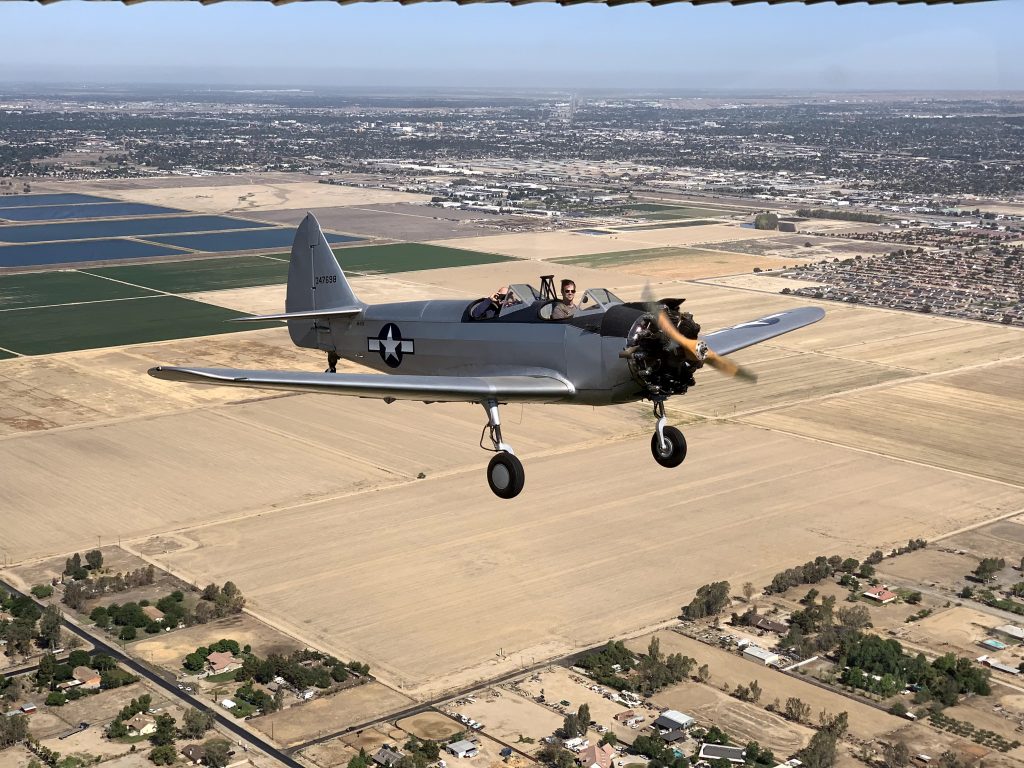
The Fairchild PT-23, a vital component of the United States Army Air Corps’ training program during World War II, was a low-wing monoplane designed to prepare novice pilots for military service. Developed by Fairchild Aircraft as part of the PT-19 series, the PT-23 was introduced in 1942 to address a shortage of Ranger engines by utilizing a Continental radial engine. Its simple yet robust design and forgiving flight characteristics made it an ideal primary trainer, helping thousands of pilots from the U.S. and allied nations take their first steps toward combat readiness. Today, our museum proudly displays a restored PT-23, a testament to its role in aviation history.
History
The PT-23 evolved from the Fairchild M-62, first flown on May 15, 1939, as the PT-19. Designed to modernize pilot training, it offered a low-wing monoplane configuration that better approximated the handling of combat aircraft compared to older biplane trainers. By 1941, the demand for trainers surged after the attack on Pearl Harbor, leading to production by Fairchild and licensed manufacturers like Aeronca, St. Louis Aircraft Corporation, and Howard Aircraft Corporation. When Ranger engine supplies dwindled, Fairchild introduced the PT-23, powered by a 220 hp Continental R-670 radial engine. A total of 1,125 PT-23s were built, including 256 PT-23A variants equipped for instrument training. These aircraft trained pilots at bases like Fletcher Field, Mississippi, and Stuttgart Army Air Field, Arkansas, with one example (USAAF No. 42-49805) bearing the line number 139. After the war, many PT-23s were sold as surplus, finding use in civilian flying clubs and agricultural roles, with some still flown by enthusiasts today.
Design Features
The PT-23 is a two-seat, tandem cockpit, open-cockpit monoplane with a fabric-covered welded steel tube fuselage and plywood-covered wings and tail assembly. Its cantilever low-wing design and wide-track fixed landing gear minimized ground loops, a common issue with other trainers like the Stearman Kaydet. The aircraft’s “duramold” plywood construction created smooth surfaces, though early models faced durability issues in humid climates, prompting later all-metal wing designs. The PT-23’s Continental R-670 radial engine distinguished it from the PT-19’s inline Ranger engine, giving it a distinctive rounded nose. The airframe aft of the firewall is identical to the PT-19B, ensuring cost-effective production.
Specifications
| Specification | Details |
|---|---|
| Manufacturer | Fairchild Aircraft (and licensed manufacturers) |
| Model | PT-23 |
| First Flight | May 15, 1939 (PT-19 prototype) |
| Entered Service | 1942 |
| Crew | 2 (instructor and student) |
| Wingspan | 35 ft 11.87 in (10.97 m) |
| Length | 26 ft 7.5 in (8.11 m) |
| Height | 7 ft 6 in (2.29 m) |
| Empty Weight | 1,970 lb (894 kg) |
| Gross Weight | 2,800 lb (1,270 kg) |
| Powerplant | Continental R-670, 220 hp (164 kW) |
| Fuel Capacity | 49 gal total, 45 gal usable (170 L, 151 L usable) |
| Range | 220–320 statute miles (354–515 km) |
| Maximum Speed | 131 mph (211 km/h) |
| Cruise Speed | 118 mph (190 km/h) at 1,800 RPM |
| Maximum Diving Speed | 191 mph (307 km/h) |
| Service Ceiling | 15,500 ft (4,724 m) |

Flight Characteristics
The PT-23 was designed for ease of use, with forgiving handling that suited novice pilots. Its higher wing loading and low-wing configuration provided flight characteristics closer to those of advanced combat aircraft, requiring precision and care. The aircraft’s maximum speed was 131 mph (211 km/h), with a cruising speed of 118 mph (190 km/h) and a stall speed of approximately 62 mph (100 km/h). Its wide landing gear ensured stable ground handling, though heavy braking could cause a nose-over, mitigated by a roll-over pylon between cockpits. The PT-23 was not suited for aerobatics but was reliable and inexpensive to maintain, making it a cornerstone of primary flight training. Pilots trained on the PT-23 transitioned to more advanced trainers like the BT-13 Valiant, preparing them for combat aircraft.
Museum Significance
Our museum’s PT-23, meticulously restored to its 1943 configuration, reflects the aircraft’s wartime appearance, complete with its all-silver finish introduced after June 1942. This aircraft, like others at bases such as Minter Field, trained thousands of pilots from the U.S., Canada, Great Britain, and other allied nations. Its preservation honors the contributions of the pilots, instructors, and Women Airforce Service Pilots (WASPs) who delivered these aircraft to training bases. Visitors can explore the open cockpit and imagine the experiences of cadets preparing for service during WWII.
